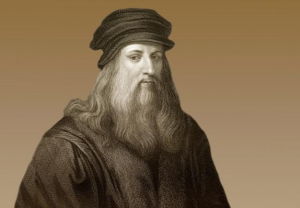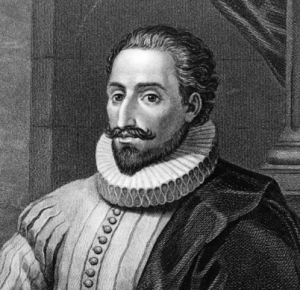Leonardo Da Vinci RENAISSANCE TEKKIE 1452 – 1519

At a time when Western civilization was emerging from what historians like to describe as the “Dark Ages”, while most early Renaissance intellectuals were re-discovering Greek culture and building on it, Leonardo engaged in pursuits that set off in multiple new directions – at the same time. Using the equivalent of his own ‘secret decoder ring’ (long before anyone had heard of comic books, breakfast cereal, or Ovaltine) and backwards handwriting, Leonardo recorded a string of inventions, discoveries, and random bits of unconventional knowledge in the notebooks known today as the “Codex”.
Miguel de Cervantes OBSESSION 1547 – 1616

Miguel de Cervantes, who comes from the land where Geek Pride Day was first celebrated – Spain – was in the prison at La Mancha (for financial discrepancies arising from the time when he sought to support himself as a tax collector) when what was to become the story of Don Quixote occured to him. Written, unusually for the time, in language as the people actually spoke it, Cervantes intended to portray real life as it was lived. What emerged was one of the world’s best panes to obsession – one of the essential pillars of geekdom. Don Quixote, famously remembered for tilting at windmills, is in fact a picture of obsession. Had he been a real person today, he would probably have put on Ritalin as a child, and lost to history.
Benjamin Franklin CURIOSITY PLUS 1706 – 1790
Benjamin Franklin is firmly established as one of America’s Founding Fathers. He was a statesman (ambassador to France at the time of the American Revolution), a politician (elected President of the Supreme Executive Council of Pennsylvania), and, along with Thomas Jefferson and John Adams, an author of the American Declaration of Independence. But he is well-known, and perhaps best known, as the man who stood out in a thunderstorm with a key dangling from the string of a kite, while the kite itself sought out a bolt of lightning (an experiment from which some experimenters in other time and places did not emerge unscathed). Benjamin Franklin, whose investigations of electricity were in fact in part responsible for his tremendous popularity in Europe, and whose invetions and experiments went far beyond, was at heart, a Yankee geek.
Marie Curie ESCHEWING THE MAINSTREAM 1867 – 1934

When Wilhelm Roentgen published his paper on the discovery of “X Rays” in 1895, it set off a flurry of activity among other scientists.
Marie Curie was just starting out as an accredited scientist, and her path to getting there had been anything but conventional, including studying chemistry in secret at a time when her family, and the world in general, did not consider it the preferred course of action for a young lady.
While others were pursuing the mainstream, Curie was fascinated by anomalies she discovered working with pitchblende – which exhibited behavior both similar to and unlike the behavior Roentgen had observed.
Working from a storeroom in her husband’s school, and then a converted shed, Curie went on to discover the concept of ‘radioactivity’ (and coined the term itself), and a new fiercely radioactive substance in pitchblende, discovering 2 new elements “radium” (from the Latin word for ray), and “Polonium” (in honor of her native land, Poland).
In the process,she made it abundantly clear (in case there was any question) that geekdom is gender neutral.

